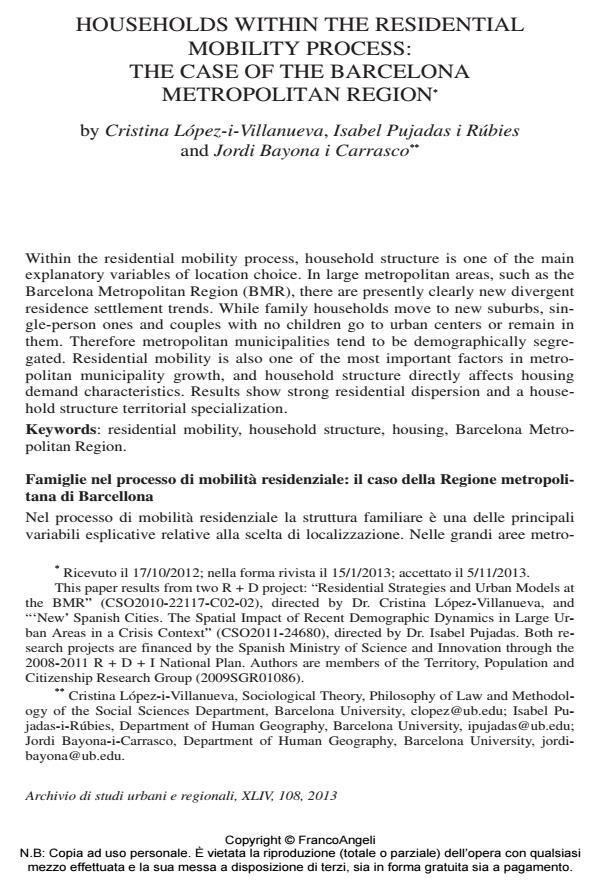Households within the residential mobility process: the case of the Barcelona metropolitan region
Titolo Rivista ARCHIVIO DI STUDI URBANI E REGIONALI
Autori/Curatori Cristina López-i-Villanueva, i Rúbies Isabel Pujadas, i Carrasco Jordi Bayona
Anno di pubblicazione 2014 Fascicolo 2013/108
Lingua Inglese Numero pagine 28 P. 57-84 Dimensione file 1808 KB
DOI 10.3280/ASUR2013-108004
Il DOI è il codice a barre della proprietà intellettuale: per saperne di più
clicca qui
Qui sotto puoi vedere in anteprima la prima pagina di questo articolo.
Se questo articolo ti interessa, lo puoi acquistare (e scaricare in formato pdf) seguendo le facili indicazioni per acquistare il download credit. Acquista Download Credits per scaricare questo Articolo in formato PDF

FrancoAngeli è membro della Publishers International Linking Association, Inc (PILA)associazione indipendente e non profit per facilitare (attraverso i servizi tecnologici implementati da CrossRef.org) l’accesso degli studiosi ai contenuti digitali nelle pubblicazioni professionali e scientifiche
Within the residential mobility process, household structure is one of the main explanatory variables of location choice. In large metropolitan areas, such as the Barcelona Metropolitan Region (BMR), there are presently clearly new divergent residence settlement trends. While family households move to new suburbs, single- person ones and couples with no children go to urban centers or remain in them. Therefore metropolitan municipalities tend to be demographically segregated. Residential mobility is also one of the most important factors in metropolitan municipality growth, and household structure directly affects housing demand characteristics. Results show strong residential dispersion and a household structure territorial specialization.
Nel processo di mobilità residenziale la struttura familiare è una delle principali variabili esplicative relative alla scelta di localizzazione. Nelle grandi aree metro politane, come la Regione metropolitana di Barcellona (BMR), sono all’oggi chiare le nuove tendenze di insediamento residenziale. Mentre i nuclei familiari si spostano verso nuovi quartieri, le famiglie mononucleari e le coppie senza figli si spostano verso i centri urbani o vi rimangono. Pertanto alcuni comuni metropolitani tendono a forme di segregazione demografica. La mobilità residenziale è anche uno dei fattori più importanti per la crescita del comune metropolitano, e la struttura familiare influisce direttamente sulle caratteristiche della domanda abitativa. I risultati mostrano una forte dispersione residenziale ed una specializzazione territoriale della struttura familiare.
Parole chiave:Moblità residenziale, strutture familiari, housing, Regione metropolitana di Barcellona
- Unraveling the (Uneven) Linkage? A Reflection on Population Aging and Suburbanization in a Mediterranean Perspective Sirio Cividino, Gianluca Egidi, Luca Salvati, in Sustainability /2020 pp.4546
DOI: 10.3390/su12114546 - Movilidad residencial y (re)composición social del espacio urbano en el municipio de Madrid Andrea Andújar, in Papers. Revista de Sociologia /2017 pp.761
DOI: 10.5565/rev/papers.2419 - Efectes de la suburbanització i la immigració internacional en l’evolució recent de la fecunditat a Catalunya: un estudi territorial a escala local Cristina López Villanueva, Fernando Gil-Alonso, Jordi Bayona i Carrasco, Jenniffer Thiers, in Documents d'Anàlisi Geogràfica /2014 pp.599
DOI: 10.5565/rev/dag.129
Cristina López-i-Villanueva, i Rúbies Isabel Pujadas, i Carrasco Jordi Bayona, Households within the residential mobility process: the case of the Barcelona metropolitan region in "ARCHIVIO DI STUDI URBANI E REGIONALI" 108/2013, pp 57-84, DOI: 10.3280/ASUR2013-108004